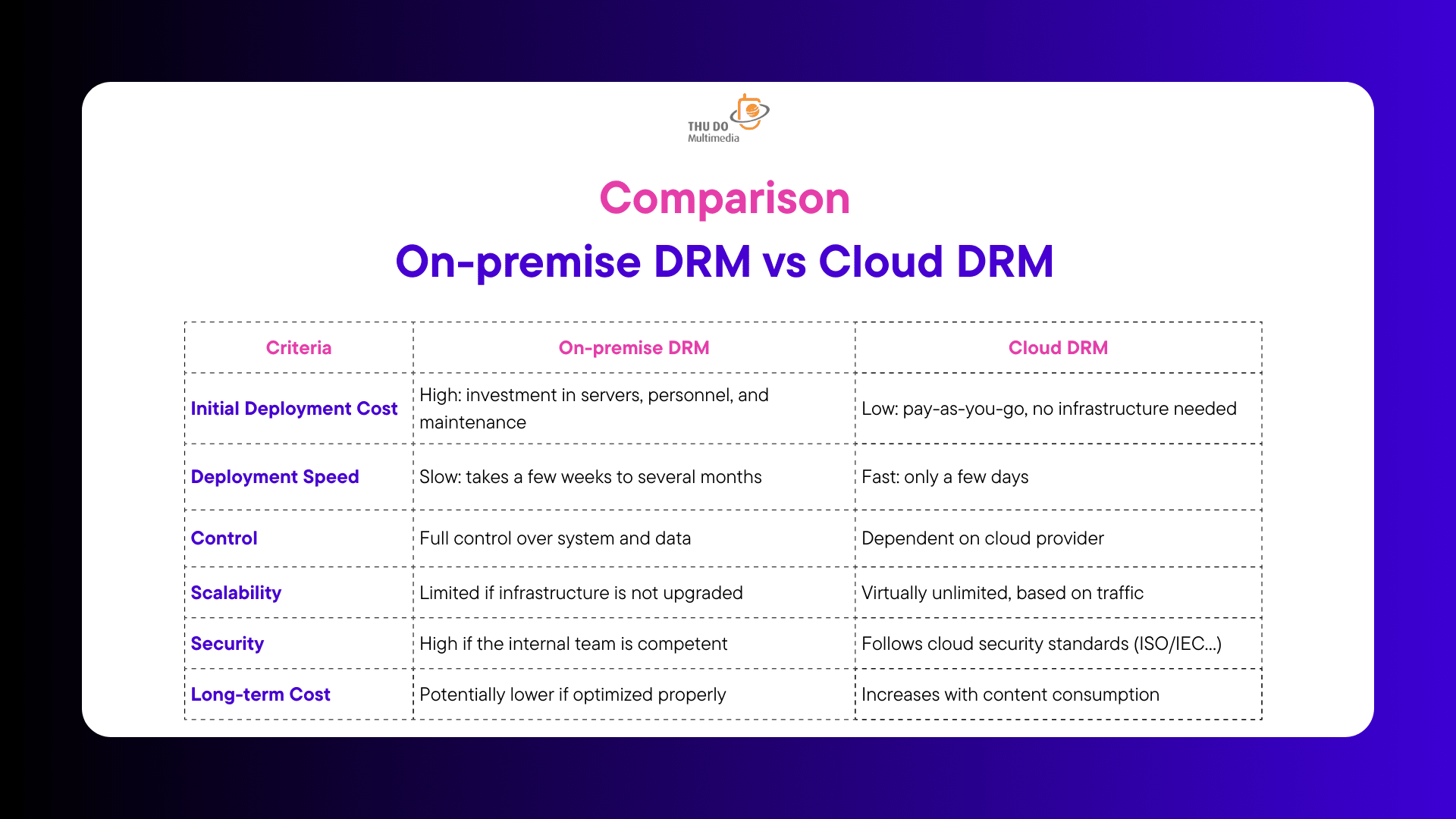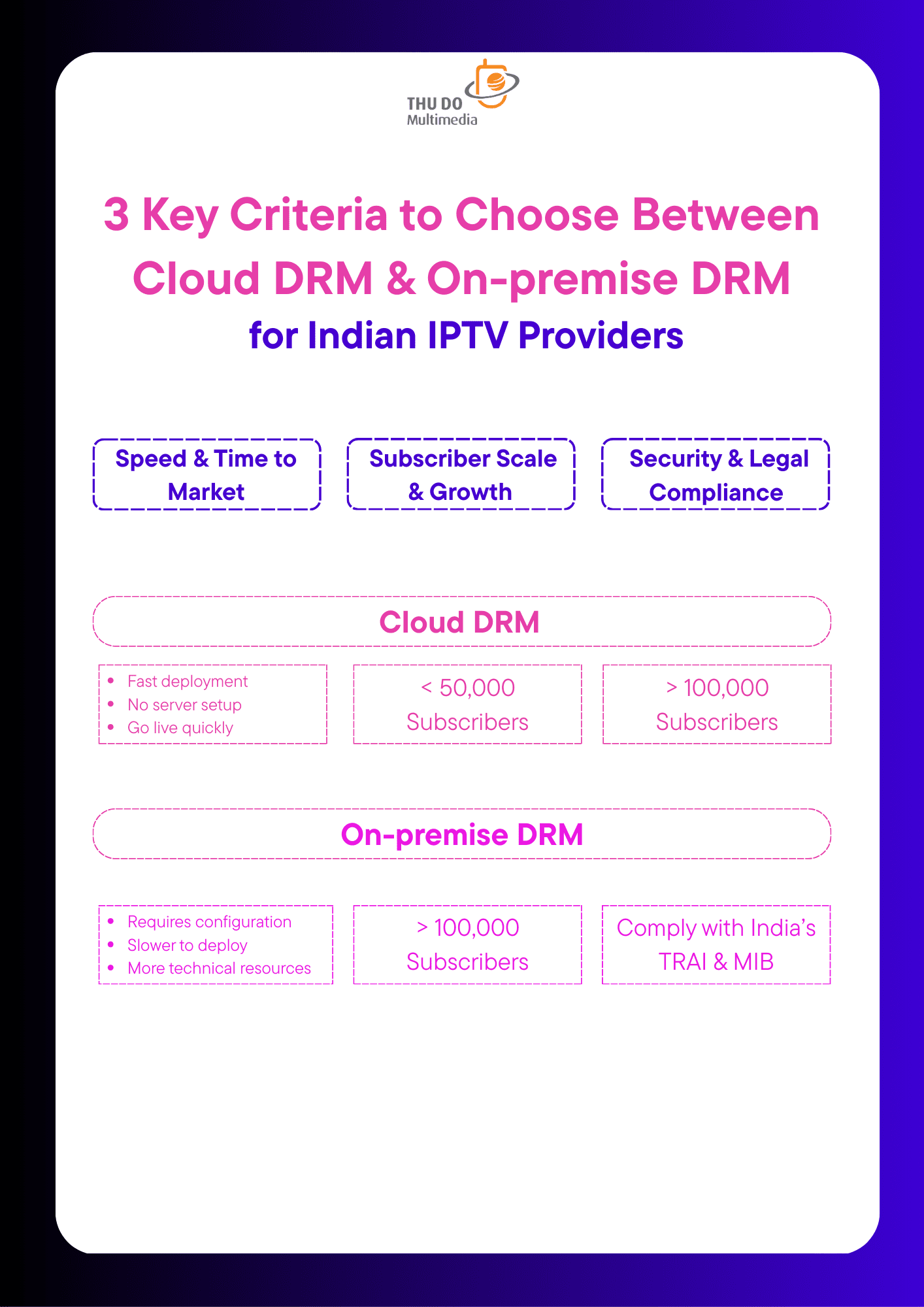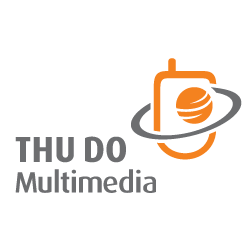On-premise DRM or Cloud DRM for IPTV in India? A comprehensive analysis comparing costs, security, and key pros and cons of each DRM solution
On-premise vs Cloud DRM: Which Solution is Best for IPTV Providers in India?
India’s expanding IPTV market is facing an urgent challenge: how to protect digital content in an age of increasingly sophisticated and widespread piracy. As a result, Digital Rights Management has become a mission-critical component of any OTT/IPTV provider’s technical infrastructure.
But for many service providers, a key decision remains unclear:
Should you choose a Cloud-based or an On-premise DRM solution?
Which one offers better cost efficiency, content security, and scalability for future growth?
This article delivers a comprehensive, practical, and expert-level comparison to help you make the most informed choice for your IPTV business in India.
Read more to know: Protecting IPTV Copyrights in India with SMS Integrated DRM & Fingerprint
Comparison On-premise vs Cloud DRM
When building a content protection system for IPTV services, especially in a highly regulated market like India, choosing between On-premise and Cloud DRM is more than a technical decision. It’s a strategic move that impacts initial investment, deployment speed, system control, and long-term security.
Each DRM model comes with its own distinct pros and cons. Before deciding, businesses must understand the core differences to align with their internal capabilities, growth goals, and local compliance requirements.
The following comparison table offers a comprehensive overview to support your decision-making:

When Should You Choose On-premise DRM?
Best for Large IPTV Providers with Strong In-house Tech Teams
If you’re a large-scale IPTV provider in India with your own server infrastructure and a skilled DevOps team, On-premise DRM could be the ideal choice. Here’s why:
- Full control to optimize the Digital Rights Management architecture based on your business-specific requirements.
- Subscriber data and content rights stay entirely within your internal systems, reducing exposure risks.
- Enables deep integration with your existing SMS, billing, and analytics platforms.
Case Study – Microsoft Security Breach, April 2025
In April 2025, Microsoft released an emergency patch for a critical vulnerability, CVE-2025-29824, found in the Windows Common Log File System (CLFS). Before the patch, ransomware groups like Play and Storm-2460 had already exploited this flaw, launching targeted attacks on major organizations across the U.S., Spain, Venezuela, and Saudi Arabia.
These attacks allowed adversaries to escalate privileges, access Active Directory information, and install malware – posing severe risks to any Windows-based system that hadn’t been updated.
Full news here: Microsoft patches zero-day actively exploited in string of ransomware attacks
However, Sigma DRM clients using On-premise DRM were completely unaffected by this breach. Thanks to isolated internal security layers and self-managed Digital Rights Management key control, they operated independently of the compromised public cloud systems.
Key takeaway: In an era of increasingly advanced cyber threats, On-premise DRM offers unmatched control and end-to-end security – something that public cloud DRM platforms simply cannot fully guarantee.
Key Evaluation Criteria for Choosing the Right DRM for IPTV Providers in India
When selecting between On-premise and Cloud DRM, IPTV providers in India must weigh multiple business and technical factors. Below are the three most critical criteria to guide your decision.
1. Deployment Speed & Time-to-Market
If your priority is speed and agility, Cloud DRM offers the fastest path to go live. It’s specifically designed for platforms that need to move quickly, whether you’re entering a competitive market, launching a time-sensitive promotion, or scaling up to meet a sudden spike in demand.
With Cloud Digital Rights Management, you can skip complex server configurations and begin securing your content almost immediately. There’s no need for hardware provisioning or custom backend deployment. Everything is managed via secure APIs, making the process straightforward and fast.
In contrast, on-premise DRM involves a more involved setup. It requires infrastructure provisioning, technical validation, QA testing, and optimization. While this offers greater control in the long term, it can significantly delay your launch timeline, which may not be ideal if you’re working under pressure or trying to beat competitors to market.
The bottom line: Choose Cloud DRM when you need rapid deployment, especially for pilot projects, MVP launches, or urgent content rollouts. It’s your go-to solution for speed without sacrificing security.
2. Subscriber Scale & Growth Projections
The number of subscribers you serve today and how quickly that number is expected to grow, plays a critical role in determining which DRM model is the right fit for your IPTV business.
If you’re managing a base of fewer than 50,000 subscribers, Cloud DRM is typically the more practical option. It’s easier to manage, cost-effective at low scale, and allows you to grow incrementally without committing to heavy infrastructure. Cloud platforms offer the elasticity to expand on demand, making them ideal for small-to-mid scale IPTV operations or new market entrants.
However, if you’re expecting your user base to exceed 100,000 subscribers, the economics start to shift. At larger scales with consistent traffic and high data throughput, On-premise DRM can become more cost-efficient over time. The ability to manage licenses, storage, and encryption locally reduces recurring cloud service fees and gives you tighter control over security, latency, and performance.
In short, Cloud DRM is ideal for early growth stages, while On-premise DRM becomes more financially viable as your platform scales and your need for control increases. Carefully evaluate your current footprint and growth trajectory to choose the most strategic path forward.
3. Data Security & Regulatory Compliance
If your platform handles premium content such as Hollywood movies, live sports, or any form of high-value programming, or if you process sensitive subscriber data, then security and regulatory compliance must be your top priorities.
In such cases, On-premise DRM is often the preferred choice. It provides maximum protection by keeping encryption keys, license servers, and user data entirely within your own controlled infrastructure. This minimizes exposure to external risks and enhances your ability to monitor, audit, and respond to threats in real time.
Alternatively, if you’re considering a cloud-based deployment, make sure to choose a certified Cloud DRM solution that meets industry standards for HD/UHD content protection, such as Widevine L1 or Apple FairPlay with secure key delivery. Not all cloud DRM providers offer the level of security required for premium rights holders, so vetting your vendor is essential.
Equally important is ensuring full compliance with Indian regulations, particularly those issued by TRAI (Telecom Regulatory Authority of India) and the Ministry of Information and Broadcasting (MIB). These regulations may mandate data localization, subscriber consent mechanisms, or specific encryption standards. Whether on-prem or in the cloud, your DRM system must align with these frameworks to avoid legal and operational risks.
Choose On-premise DRM for stricter control and compliance, or verify that your Cloud DRM provider meets industry-grade security certifications.

Which DRM Option Is Best for You?
There’s no one-size-fits-all solution when it comes to choosing between On-premise and Cloud DRM for IPTV providers in India. The right choice depends on your business goals, infrastructure, and stage of growth.
If you’re an established IPTV provider with an in-house DevOps team and robust infrastructure, on-premise DRM is often the superior choice. It gives you full control over your architecture and data, allowing for tighter security protocols tailored to your operations. This is especially important when handling premium or exclusive content, where any breach could lead to major revenue losses or legal consequences. On-premise DRM also enables seamless integration with your internal systems, such as Subscriber Management Systems (SMS), billing platforms, and analytics dashboards, ensuring performance, traceability, and compliance are all maintained within your own environment.
On the other hand, if you’re a startup or scaling IPTV platform aiming to go to market quickly and minimize upfront investment, cloud-based DRM can be your fastest and most efficient route. With faster deployment timelines, lower initial infrastructure costs, and hassle-free scalability, cloud DRM lets you focus on growth without getting bogged down in complex implementation. You can launch services faster and pivot more easily as your business model evolves.
Pro Tip: Many Indian IPTV providers begin with cloud DRM to accelerate time-to-market, then gradually transition to on-premise DRM as their subscriber base grows and compliance demands increase. This hybrid approach offers the best of both worlds, speed today and control tomorrow.ders adopt a hybrid approach – starting with Cloud DRM for rapid launch and migrating to On-premise DRM as their subscriber base and data security needs grow.
Read more to understand: DRM-SMS Integration Roadmap to Tackle IPTV Piracy at Its Root in India 2025
Recommended DRM Providers for IPTV in India
Choosing the right DRM provider is as important as deciding between On-premise and Cloud deployment. Here are three widely used DRM solutions among Indian IPTV providers:
Widevine (by Google)
One of the most widely adopted DRM solutions globally, Widevine supports multiple platforms and is trusted by major streaming services.
PlayReady (by Microsoft)
Well-integrated with Windows environments and Smart TVs, PlayReady has been a strong player in the market.
However, recent industry analyses have raised concerns about its declining trust in terms of security robustness.
Sigma DRM
Built specifically for the Indian IPTV ecosystem, Sigma DRM offers:
- Deep integration with Subscriber Management Systems (SMS)
- Flexible architecture for both On-premise and Cloud
- Optimized for compliance with Indian regulations
Still Unsure Which DRM to Choose?
If you’re still debating between Cloud DRM vs On-premise DRM, we’re here to help.
Let our Sigma DRM experts assist you with:
➡ Evaluating your current infrastructure
➡ Recommending the most efficient architecture
➡ Delivering a live demo of content protection in action
Book your free consultation today and find the perfect DRM fit for your IPTV business in India!


Recent Comments